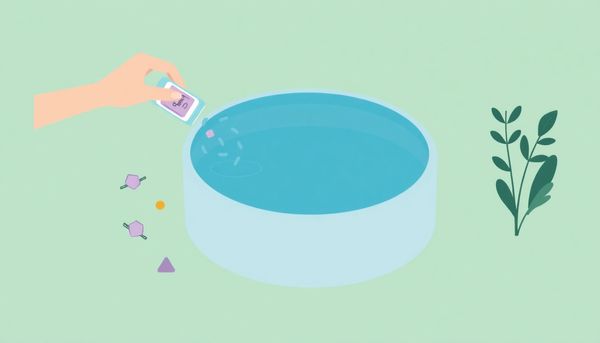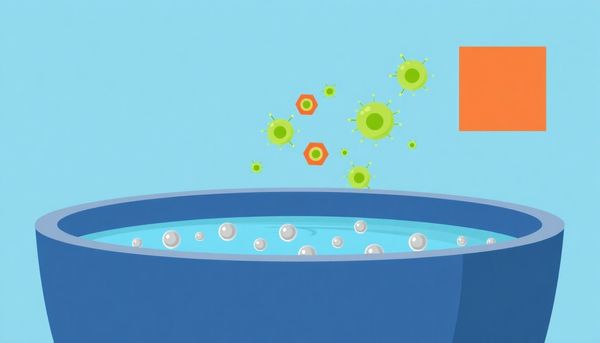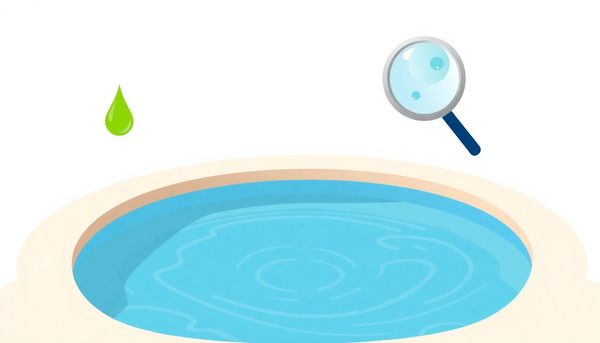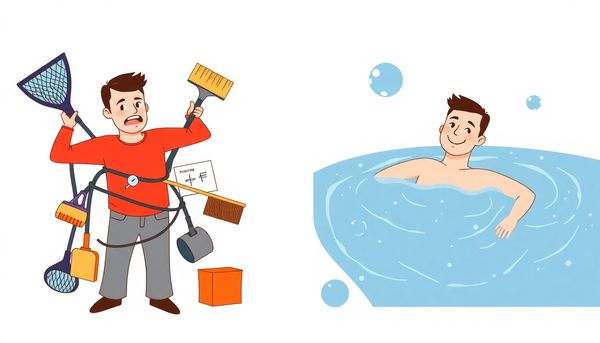Discover the Benefits of Mineral Sanitizers for Your Hot Tub
April 25th, 2024
April 25th, 2024
Stepping into a hot tub after a long day is more than just a comfort; it’s a ritual that soothes the body and mind. The warm embrace of water can wash away the stresses of daily life, but maintaining this sanctuary requires some understanding of water care. A key component in this endeavor is the use of mineral sanitizers. Unlike conventional chemical treatments that often leave a strong smell and irritate sensitive skin, mineral sanitizers offer a more natural and gentle solution.
Several years ago, when I first installed a hot tub in my backyard, I was overwhelmed by the multitude of maintenance options. The idea of constantly handling harsh chemicals was daunting. That’s when I stumbled upon mineral sanitizers. These nifty tools not only promised a more pleasant soaking experience but also simplified my maintenance routine. Because they rely on natural elements like silver and copper to purify the water, I found myself spending less time fussing over chemical balances and more time savoring the serenity of my hot tub.
In this guide, we will unravel the mysteries of mineral sanitizers and explore their benefits. From understanding how they work to choosing the right one for your needs, you’ll discover how to transform your tub into an oasis that’s both inviting and easy to manage. Welcome to a new way of enjoying your personal spa haven.

Chlorine's reputation in the world of hot tubs is indeed impressive—it's effective and widely trusted. Yet, the drawbacks are hard to ignore: it can leave your skin feeling like sandpaper and your hair resembling straw. Not to mention the dreaded chlorine smell that can cling to you long after a soak. That's where mineral sanitizers come into play, offering a gentler alternative without skimping on efficacy.
Mineral sanitizers primarily harness the power of silver and copper to combat common spa nuisances. Silver has long been a hero in the fight against bacteria, a role it has played since antiquity, while copper tackles algae with remarkable efficiency. Together, they form a formidable team, reducing the need for high chlorine levels and thus, the associated harshness. Add a dash of limestone to the mix, and you have a natural pH balancer, as it absorbs excess acid.
One of the great perks of using mineral sanitizers is their cost-effectiveness. Compared to the continuous cycle of purchasing chlorine or bromine, these minerals offer a more budget-friendly approach. Plus, they simplify maintenance with easily replaceable cartridges, eliminating the need for constant chemical juggling.
However, be mindful of potential copper stains, especially if your local water supply already contains high levels of this mineral. A metal sequestrant can mitigate this issue if used judiciously, ensuring your spa remains a haven of relaxation rather than a battleground of chemical excess. Balancing innovation with tradition, mineral sanitizers could just be the refreshing change your spa routine needs.
Reconsider the role your hot tub plays in your self-care routine. While chlorine is a tried-and-true sanitizer, its abrasive effect on hair and skin can't be ignored. Here steps in the unsung hero: hot tub mineral sanitizers. Envision a soak that leaves you feeling revitalized, not parched—where your skin is gently cradled by the water, not stripped of its natural oils.
Mineral sanitizers leverage the ancient antibacterial prowess of silver and copper. Silver, with its storied history, wages war against bacteria, while copper diligently tackles algae. This dynamic duo not only keeps your water sparkling but also reduces your dependence on harsh chemicals. By decreasing chlorine usage to a mere whisper of 0.5 ppm, you sidestep the dreaded chloramines and their pungent aroma.
Consider their economic edge as well. Mineral cartridges require replacement only every few months, unlike the frequent replenishment chlorine demands. This lessens the burden both on your wallet and the environment. Plus, the simplicity of mineral systems—be it a stick slipped into a filter or a floating dispenser—eliminates the hassle of measuring and mixing.
However, a careful balance is required. Copper, although effective, can lead to staining if overused, particularly in already mineral-rich water sources. A metal sequestrant, used sparingly, may help avert this issue. When paired wisely with minimal chlorine, mineral sanitizers transform your hot tub from a chemical haven to a skin-friendly sanctuary.
Minerals are more than just elements lurking in the earth or hidden in supplements; they hold the potential to revolutionize your hot tub experience. Chlorine, while a staple in water sanitizing, often leaves skin dry and hair brittle. But what if you could harness the purifying power of natural minerals to combat these downsides? By employing silver and copper-based mineral sanitizers, you introduce a gentle yet effective method to keep your spa pristine.
Silver’s storied past as an antibacterial agent dates back centuries, with copper proving its worth against algae in modern times. These minerals, when used in your hot tub, drastically cut down the need for harsh chemicals. The result? Softer water that’s kind to your skin, not to mention a significant reduction in the infamous chloramine smell. The simplicity of mineral systems is another advantage; replace a mineral cartridge every few months and you're set. It’s a hassle-free alternative to the tedious routine of measuring and mixing chemicals.
However, be mindful of copper's potential to stain if your water source is already rich in metals. A metal sequestrant can help manage this, though using it sparingly is crucial to maintain the efficacy of the sanitizer. While minerals alone won't suffice for complete sanitization—supplementing with minimal chlorine or bromine is necessary—they offer a balanced, skin-friendly solution that transforms your hot tub into a haven of relaxation rather than a chore.
Maintaining a spa can feel like juggling a dozen tasks at once, but it doesn't have to be that way. Embracing the simplicity of a hot tub mineral sanitizer can transform your routine while keeping your spa in tip-top shape. Forget the endless cycle of testing and adjusting chlorine levels, and say goodbye to the harsh odors and skin irritation that often accompany traditional sanitizers.
Mineral sanitizers, leveraging the natural purifying properties of silver and copper, offer a streamlined alternative. Silver’s historical use as an antibacterial agent, paired with copper’s proven ability to combat algae, ensures that your spa remains clean and inviting. By reducing the need for high levels of chlorine, these minerals provide a gentler touch on both your skin and spa surfaces.
Instead of frequently measuring and mixing chemicals, you simply replace the mineral cartridge every few months. This not only simplifies your maintenance routine but also reduces the frequency of water testing. The beauty of this system lies in its ability to maintain a balanced pH, minimizing the unpredictability often associated with chlorine.
Consider the financial benefits, too. While initial costs for a mineral sanitizer might seem comparable, over time, the decreased need for additional chemicals can lead to savings. Plus, you’re likely to experience fewer skin and hair issues, saving on products designed to counteract chlorine's effects. Embrace the ease of mineral sanitizers and enjoy more carefree spa sessions.

Choosing between chlorine and minerals for your hot tub can feel like deciding between a familiar sitcom and a new series with rave reviews. Chlorine has long been the go-to, known for its reliable bacteria-busting power. However, it can leave your skin feeling like you've just exited a desert and your hair yearning for extra conditioner. The cost isn't outrageous, but it's not the most economical choice, especially when considering the potential for chloramine buildup—a problem nobody invites to their spa party.
On the flip side, hot tub mineral sanitizers offer a gentler alternative. Imagine harnessing the ancient antibacterial prowess of silver and the algae-fighting skills of copper. These minerals team up to maintain clear and inviting waters, significantly reducing your chlorine dependency. Not only does this mean softer skin, but it also eliminates that notorious chlorine odor. Plus, swapping out a mineral cartridge every few months is less of a chore than consistently measuring and balancing chemicals.
Yet, it's not all spa days and relaxation. Copper can stain your hot tub if not managed carefully, especially when combined with water already rich in metals. A metal sequestrant can help, though it requires a delicate touch to avoid diminishing the sanitizer's effectiveness. Ultimately, opting for minerals means a slightly higher initial investment and continued use of minimal chlorine. But for many, the promise of a more natural, user-friendly experience is worth the shift.
Exploring the world of hot tub maintenance might seem overwhelming, but considering mineral sanitizers could be a game-changer. These small yet potent additions tap into the natural power of silver and copper. Historically, silver was a trusted ally in the fight against bacteria, even back in Roman times. Similarly, copper, revered for its ability to combat algae, has been a mainstay in pool and spa care.
Mineral sanitizers offer the bonus of reducing chlorine dependency, sparing your skin from harsh chemicals and minimizing that unmistakable chlorine odor. Imagine soaking in a hot tub without the fear of dry skin or frizzy hair. Not only are minerals gentle, but they’re also cost-efficient. With less frequent replacements and simpler upkeep, you'll find them kinder on the wallet too.
Of course, while the benefits are numerous, it’s essential to be mindful of potential pitfalls. Copper, for instance, can stain your spa if not managed properly. A metal sequestrant can help, but moderation is key to maintaining the efficacy of the minerals.
Ultimately, the combination of mineral sanitizers with a touch of chlorine or bromine ensures comprehensive water cleanliness, tackling bacteria and viruses effectively. By weighing the upsides and considering mineral advantages, you may find a more harmonious balance in your spa experience, achieving the ultimate in relaxation without compromising on hygiene or comfort.
Balancing the budget while enjoying the luxury of a hot tub is a delightful challenge. When considering the shift to a mineral sanitizer system, the cost-effectiveness is a major draw. Unlike traditional chlorine or bromine systems that require regular purchasing and precise handling, mineral systems offer a more streamlined approach. With mineral sticks or cartridges, you simply pop them into your hot tub's filter, no gloves or measurements necessary.
Take my neighbor, who swore by chlorine for years but constantly battled with dry skin and the relentless smell. After switching to a mineral system, not only did she notice her skin felt softer, but her bathroom shelves were less cluttered with various chemical containers. The initial investment in mineral sanitizers can appear steep, but they last longer, requiring replacement only every three to four months. This longevity can translate to significant savings, especially if your hot tub sees moderate use.
Moreover, reducing the need for high levels of chlorine cuts down on additional purchases and maintenance time. Some might argue that you’re still buying chlorine, but the reduced quantity needed means those purchases are less frequent. Plus, the energy saved from not having to frequently test and add chemicals is a win in itself. Ultimately, the decision hinges on personal priorities, but for those valuing ease and economy, mineral sanitizers present an appealing option.
In the world of hot tub care, no solution comes without its quirks, and mineral sanitizers are no exception. While they offer a gentler alternative to traditional chlorine, some challenges require attention. Copper, a key mineral in these sanitizers, can be a double-edged sword. On one hand, it fights algae effectively; on the other, it might stain your hot tub if left unchecked. If your local water supply is already high in copper, adding more might spell trouble. Enter metal sequestrants—these act as bouncers, keeping copper from sticking around where it shouldn't. However, use them sparingly; too much can diminish the sanitizer’s effectiveness.
Another aspect to consider is that mineral systems aren't a complete replacement for chlorine or bromine. While they allow you to use significantly less of these chemicals, they still need to tag along for the ride to ensure thorough sanitation. This dual approach might initially appear costly, but often, the decreased chlorine usage balances the scales over time.
Lastly, always keep an eye on water balance. Minerals work best when pH and alkalinity are just right. A well-managed hot tub means fewer surprises and more relaxing soaks. So, as you embrace the mineral path, remember to maintain a vigilant eye on your spa’s chemistry, steering clear of unexpected hiccups.

In the realm of hot tub maintenance, innovation sometimes emerges from the annals of history. Two metals—silver and copper—have long been celebrated for their antimicrobial properties. These elements were known to ancient civilizations, revered for their ability to ward off infections and disease. Today, they are the unsung heroes of modern hot tub mineral sanitizers.
Silver’s antibacterial prowess harks back to the Romans, who recognized its potential to keep water fresh. Meanwhile, copper battles algae with a tenacity that makes it indispensable in pool and spa care. When paired, these minerals provide a formidable defense against not only bacteria but also algae, creating a safer, cleaner environment for relaxation.
A friend of mine, a long-time hot tub enthusiast, once grumbled about the harshness of traditional sanitizers on her skin. It was only after she switched to a silver-copper system that she noticed a significant difference. Her spa time became more enjoyable, free from the dry skin woes and pungent chlorine scent she had tolerated for years.
These mineral systems are not only gentle on the skin and hair, but they also reduce the need for high doses of chlorine. This translates to fewer chloramines—those unpleasant compounds responsible for the typical "pool smell." However, a word of caution: copper can stain if unmanaged. Thus, regular maintenance and possibly a metal sequestrant might be necessary.
Incorporating silver and copper into your hot tub routine offers a blend of ancient wisdom and modern convenience, promising a more pleasant spa experience.
Imagine stepping into a hot tub where the water is as gentle on your skin as a warm summer rain. Unlike the harshness of traditional chlorine, mineral sanitizers offer a refreshing alternative. Minerals like silver and copper, known for their antibacterial and algae-fighting properties, transform your spa experience into a luxurious retreat. Picture spending more time relaxing and less time worrying about chemical levels.
For those who love the idea of spa maintenance made easy, mineral sanitizers deliver. With minimal chlorine needed, the dreaded chloramine odor becomes a distant memory. No more fumbling with gloves or measuring cups; simply insert a mineral cartridge into the filter or let a floating dispenser work its magic. The convenience doesn’t end there. These systems require fewer replacements compared to their chemical counterparts, making them cost-effective over time.
Yet, every choice has its considerations. Mineral sanitizers can sometimes lead to staining if your water source contains high copper levels. A simple solution? Use a metal sequestrant to keep surfaces pristine. And remember, while minerals significantly reduce chlorine use, a little supplement with chlorine or bromine is essential for comprehensive sanitation.
Ultimately, embracing mineral sanitizers means softer skin, less maintenance, and a more natural feel to your hot tub soak. It’s not just about keeping the water clear; it’s about enhancing the entire experience. With a little knowledge and the right setup, your hot tub can be a sanctuary of tranquility.
Staining can be an unwelcome surprise after a relaxing soak in the hot tub. Those lovely mineral sanitizers that make hot tub maintenance seem like a breeze can sometimes come with the risk of unpleasant discoloration, especially when copper is involved. When copper levels in your spa water rise, they can lead to unsightly stains on your spa surfaces. But don't worry; there's a nifty solution to keep your hot tub looking pristine: metal-sequestrants.
Think of metal-sequestrants as your spa's best friend in its fight against staining. They work by binding with the metals in the water, keeping them from settling on surfaces where they could leave their mark. When used correctly, they ensure that the copper, which is a key player in mineral sanitizers, remains active in cleaning your tub without the drawback of staining.
However, it’s crucial to strike the right balance. Overzealous use of metal-sequestrants can dilute the efficacy of your mineral sanitizer. It's a bit like seasoning a dish—too much, and the flavors get lost. Use the sequestrant sparingly, always adhering to the manufacturer's guidelines. By incorporating this extra step into your maintenance routine, you can enjoy all the benefits of a mineral sanitizer without the hassle of battling stains. It's a small adjustment that makes a significant difference, keeping your hot tub both beautiful and inviting.
The task of maintaining a hot tub can often feel like an endless cycle of testing and adjusting chemicals. However, mineral systems offer a refreshing alternative that not only simplifies this routine but also enriches the hot tub experience. Mineral sanitizers harness the natural purifying properties of elements like silver and copper, long cherished for their antimicrobial prowess. Picture the Romans, who knew the value of silver's antibacterial qualities, and how modern science has harnessed this in a convenient form for your hot tub.
Incorporating a mineral system into your hot tub routine means less dependency on harsh chemicals such as chlorine. This shift offers immediate benefits: gentler water on your skin and a significant reduction in that notorious chlorinated aroma. Instead of constantly wrestling with chemical balances, a mineral cartridge quietly works over several months, maintaining the clarity and safety of your water with minimal intervention.
Let’s not forget the economic side. While initial costs for mineral systems exist, they often result in savings over time compared to traditional sanitizers. Moreover, they align well with both chlorine and bromine systems, allowing a seamless transition. Whether your tub sees frequent use or is a weekend retreat, mineral systems adapt, providing consistent water quality without the fuss of frequent chemical adjustments. Embrace this approach, and let your hot tub become a serene sanctuary, free from the tyranny of complex maintenance schedules.

A relaxing soak in a hot tub can quickly turn into a vexing ordeal if unsightly stains start appearing on its pristine surface. This is where the savvy use of metal sequestrants can save the day. If you’re using a mineral sanitizer system that employs copper, there’s a slight chance your tub could develop stains. This happens because excess copper in the water can precipitate and settle on surfaces, leaving unwanted marks.
To tackle this, a metal sequestrant acts like a vigilant guard. It binds to the metal ions, like copper, preventing them from depositing onto the spa shell. This clever solution ensures the metal remains suspended in the water, allowing your filter system to sweep it away harmlessly. It's akin to having a dedicated housekeeper who never lets dirt sit around long enough to cause problems.
However, moderation is key. Overenthusiastic use of sequestrants can undermine the effectiveness of your mineral sanitizer, leaving you with water that’s not as clean as you’d like. A little goes a long way, so applying it sparingly is your best bet. A friend once learned this the hard way, leading to a less effective sanitation process.
By maintaining this balance, you maximize the benefits of mineral sanitation while keeping your hot tub looking spotless and inviting. So, embrace the power of sequestrants and keep those stains at bay, without compromising on the cleanliness of your soak.
Copper stains in your hot tub can be as unwelcome as soggy socks after a rainstorm. While copper plays a crucial role in mineral sanitizers by combating algae, too much of it can leave your spa looking less than pristine. It's like when you accidentally spill coffee on your favorite white shirt—annoying and hard to ignore.
To sidestep these copper-related woes, understanding the chemistry of your water is key. If your water source already contains high levels of copper, adding more through mineral sanitizers might just be asking for trouble. It's akin to pouring more salt into an already salty stew. In such cases, a metal sequestrant can be your savior. This clever product binds with the copper, preventing it from settling onto surfaces and allowing your filter to whisk it away.
Yet, it's essential to tread carefully. Overusing a sequestrant might inadvertently reduce the effectiveness of your mineral sanitizer. Think of it like adding too much milk to your tea; it can dilute the intended flavor.
Regular water testing is your best friend here. Monitoring and adjusting metal levels can keep your hot tub’s appearance and function in check. With the right balance, you can enjoy the benefits of mineral sanitizers without the pesky stains. Now, that's a win for both you and your hot tub.
Balancing the water in your hot tub is more than just a task; it’s the key to unlocking a truly luxurious soak. Mineral sanitizers offer a natural harmony to your spa experience, reducing the need for harsh chemicals while maintaining pristine water conditions. Unlike chlorine, which can strip your skin and hair of its natural oils, mineral sanitizers work gently, leveraging the age-old power of minerals like silver and copper to maintain clarity and cleanliness.
Consider the simplicity: fewer chemicals, fewer adjustments, and notably, fewer concerns about chloramines disrupting your serene spa moments. By adding a mineral sanitizer, you're not only cutting back on chlorine usage but also embracing a kinder approach to water care. This means your skin feels softer, your hair stays vibrant, and you sidestep the notorious chemical smell that chlorine sometimes brings along.
A friend once shifted to mineral sanitizers and marveled at the transformation. Their spa became a haven of relaxation rather than a chemical pit stop. They described their water as feeling 'silkier', a testament to the natural balance that mineral systems bring. With the consistent gentle release of minerals, you ensure your hot tub remains an oasis of comfort and tranquility.
So, when considering your options, remember this: enhancing water balance with mineral sanitizers is not just a choice; it's an invitation to a better, more enjoyable spa experience.
Balancing the delicate dance of water maintenance in your hot tub can be tricky, yet the use of mineral sanitizers offers a simpler, gentler alternative to traditional chlorine-heavy systems. The secret lies in harnessing the antimicrobial properties of silver and the algae-fighting strength of copper. While you may still need a modest amount of chlorine, the reduction significantly lessens the harsh effects on your skin and hair, making your soak more enjoyable.
Incorporating mineral sanitizers into your routine is straightforward. These systems typically come in easy-to-use cartridges or sticks that fit into your spa’s filter system, releasing minerals into the water as it circulates. This minimizes the fuss of measuring and handling chemicals—no more guessing games with chlorine granules. For the environmentally conscious and penny-wise, mineral sanitizers present a cost-effective solution, cutting down on the frequency of chemical purchases and replacements.
However, caution should be exercised with copper levels, as excessive amounts may lead to aesthetic issues like staining. Utilize a metal sequestrant to manage copper content effectively. It is important to remember that minerals alone aren't a magic bullet; they should complement your existing regimen of chlorination or bromination to ensure comprehensive sanitation.
By optimizing mineral sanitizer use, not only do you enhance the quality of your water, but you also embrace a more sustainable approach to spa maintenance. With balanced water and fewer chemicals, your hot tub becomes a haven of relaxation—a place where you can unwind without worries.

For anyone who’s ever felt overwhelmed by the demands of spa upkeep, there's good news: spa maintenance doesn’t have to be a chore. Mineral sanitizers have revolutionized the way hot tubs can be maintained, making tasks simpler and more user-friendly. Typically, when handling chlorine, there’s a constant need for measuring, adjusting, and balancing. Now imagine replacing that with a system where the minerals do most of the heavy lifting.
Consider this: with a mineral sanitizer, your spa’s water can remain fresh and inviting without the constant addition of harsh chemicals. Silver and copper, the magic duo of many mineral systems, continuously work to keep bacteria and algae at bay. Their ability to sanitize without the frequent need for intervention allows for a more relaxed maintenance routine. This means fewer days spent with test strips and more time soaking in tranquility.
What’s more, transitioning to a mineral system involves little hassle. Simply insert the mineral cartridge into your spa’s filter or use a floating dispenser, and let it work its magic. The cartridges only need replacing every few months, aligning perfectly with a low-maintenance lifestyle. By simplifying the maintenance process, these mineral systems not only reduce your workload but also enhance your enjoyment, leaving you more time to unwind in your personal oasis.
In the world of hot tubs, chemical balance is the unsung hero of a soothing soak. While chlorine has long been the go-to for many, its harsh side effects—think dry skin or that unmistakable chemical odor—often leave spa enthusiasts seeking alternatives. Enter the world of mineral sanitizers, a game-changer in the pursuit of a gentle, yet effective, hot tub experience. Mineral sanitizers harness the natural disinfecting power of elements like silver and copper. Silver, revered since ancient times for its antibacterial properties, pairs with copper, an algae-fighting powerhouse, to create a harmonious balance in your spa.
Imagine reducing your chlorine usage down to just 0.5 ppm, which is not only kinder to your skin but also lessens that infamous chlorine smell. By integrating a mineral sanitizer into your hot tub’s filtration system, like a stick or floating dispenser, you simplify maintenance. There’s no need for precise chemical measurements or protective gear—just a straightforward setup that gradually releases minerals to keep your water pristine.
However, it’s crucial to be mindful of copper staining, especially if your water source already contains high levels of copper. A metal sequestrant can help, but use it sparingly to maintain the mineral sanitizer’s effectiveness. Ultimately, choosing to optimize chemical usage with mineral sanitizers means more time enjoying your hot tub and less time managing it, creating a seamless blend of relaxation and efficiency.
Mineral sanitizers offer a refreshing alternative for those seeking a gentler approach to hot tub care. Unlike traditional chlorine, which can leave hair brittle and skin dry, mineral sanitizers harness the natural powers of silver and copper. These elements have been trusted for their antibacterial and algae-fighting properties since ancient civilizations first discovered their benefits. Imagine stepping into your hot tub and feeling the silky smooth difference—no irritating chlorine smell, just fresh, clean water.
Each soak becomes a more pleasant experience as mineral sanitizers reduce the need for high chlorine levels. The clever interplay of silver and copper actively works against bacteria and algae, while some systems even incorporate limestone to neutralize pH levels, creating a balanced spa environment. The simplicity of using mineral sanitizers saves time and effort, as there's no need to meticulously measure out chemicals; just replace a cartridge every few months, and let the natural elements do their magic.
Moreover, the cost-effectiveness of mineral sanitizers can't be overlooked. They are generally more economical than traditional options, offering savings while maintaining water clarity and safety. However, be mindful of copper's potential to stain if water sources are already high in this mineral. With a careful approach to maintenance and balance, mineral sanitizers can transform your hot tub into a haven of relaxation, free from harsh chemical repercussions.

This article provided insights into maintaining your pool. Start your pool care journey today!
Want to become a pool maintenance expert? Our free Pool School course covers everything you need to know about pool care. From basic maintenance to advanced troubleshooting, you'll learn how to:
Join over 10,000 pool owners who have already transformed their pool care routine. Get started with our free Pool School course today!